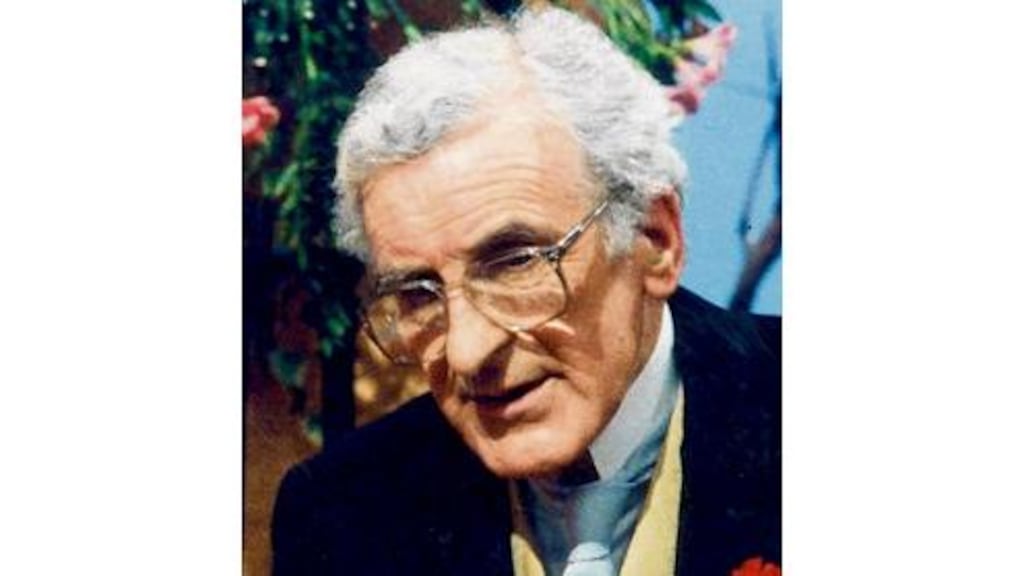TOM MURTAGH:TOM MURTAGH, who has died aged 90, was a jeweller and antique dealer in Dublin whose encyclopaedic knowledge combined with a keen sense of theatre enabled him to have a late flowering on television.
For many years in the 1980 and 1990s, he had a regular slot on RTÉ One television's L ive At Three,an afternoon magazine programme. He sometimes donned period costume to enhance his description of whatever antique items or objets d'art formed the centrepiece of his slot, encouraged by interviewers Thelma Mansfield and Derek Davis.
A flourishing part of his small antique business in Dublin included ear piercing. During one live RTÉ broadcast, he pierced the ear of reporter Kevin O’Connor, who gamely volunteered for the ordeal.
A dapper dresser with a fondness for a button hole, Murtagh’s RTÉ slot succeeded partly because he was adept at spinning a yarn but also because he used presentational flourishes acquired during many years with the Rathmines and Rathgar Musical Society.
In the 1960s he was an R&R chorus regular during their twice-yearly seasons, held then at the Gaiety Theatre, now in the National Concert Hall.
Tom Murtagh was born in 1919, the sixth child to parents Arthur Murtagh and his wife Mary (nee Hunter). Arthur was a gardener in Dublin’s Merrion Square and the family lived in a now-demolished gardener’s lodge, a cottage behind the Rutland Memorial, a drinking fountain for horses set within the square’s railings opposite the National Gallery. The cottage was within the Church of Ireland parish of St Ann’s Church on Dawson Street which the family attended and where Tom got his first taste for music.
He attended St Patrick’s Cathedral school where he joined the choir. In 1935, on the nomination of Dr George Hewson, then organist and master of the choristers, he received the Marchant Medal, an annual award for enunciation.
Hewson became something of a father figure and helped deepen Murtagh’s love of religious and classical music, a gift that enriched his life to the end.
On leaving school, Murtagh joined West and Sons, the long-established Grafton Street firm that styled itself “the king’s jewellers”. It numbered among its clients most members of the (by then declining) Anglo-Irish ascendency as well as the elite of Dublin’s burgeoning professional class.
Murtagh joined West’s sales team and learned his trade, specialising in Irish silver and gemology. He became familiar with a Dublin artisan class of silversmiths, goldsmiths, gemstone specialists and engravers that, like the inner-city working class Protestant community of which Murtagh’s family were examples, has now largely disappeared.
Many of these craftsmen occupied dingy rooms in the area between Grafton Street and South Great George’s Street in Dublin’s south inner city.
When Murtagh was eventually appointed manager of West’s, further success seemed assured. When Capt West, then head of the firm and his sponsor, died and control passed to his son Desmond, the company took a direction that did not suit Murtagh and he left.
In the mid-1960s, he opened his own business, the Dawson Boutique on Dawson Street, where he specialised in Irish silver and Victorian jewellery and quickly won a loyal clientele.
In 1946, a friend invited him to a Gilbert and Sullivan evening where he was introduced to a young woman, Olive de Lacy. He fell in love with both.
He joined the Rathmines and Rathgar and wasted little time calling to the young woman’s home in Ranelagh where, dressed in tails and wearing a white silk scarf, he asked her stern mother whether “Miss de Lacy might come out to play”. She did and in 1947, they married in the Lady Chapel of St Patrick’s Cathedral, a union that lasted 57 years.
Apart from being a chorus regular for the R&R, he was one of a very camp three-man skit on the life and times of Oscar Wilde, during the society’s golden jubilee year show of 1963. Their turn was built around Noel Coward’s Green Carnation song from his operetta Bitter Sweet.
He was the society’s treasurer and was responsible with others for the decision to buy its rehearsal rooms in Upper Rathmines Road, its permanent home ever since. He was an honorary life member of the R&R and also of the Irish Antique Dealers’ Association.
Predeceased by his wife in 2003, Tom Murtagh’s declining years were marked by growing frailty and failing eyesight. His mind though remained sharp to the end and he retained his capacity for witty quips, often laced with gallows humour regarding his own condition. His funeral took place on his 91st birthday.
He is survived by his children, Nigel, Peter and Jane, their spouses and seven grandchildren.
Tom Murtagh: born January 4th, 1919; died January 1st, 2010










